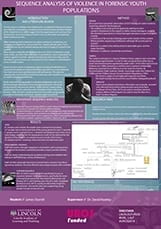by James Starritt

The UROS scheme represented an opportunity to undertake academic research into an area that I am passionate about. I have significant experience in working directly with young people who exhibit emotional and behavioural difficulties, which are then manifested in offending. I developed my hypothesis drawing upon professional, anecdotal experience, coupled with research and consultation gathered over the course of the academic year. I approached Dr David Keatley to be my Research Supervisor. Dr Keatley was immediately enthusiastic about my proposal, which enabled me to undertake research into the theory and methodology of Behaviour Sequence Analysis, and determine the feasibility of completing research using CCTV footage of real-life violent incidents.
Throughout the project, my hypothesis remained broadly unchanged, although there were significant changes within the methodology and the scope of the research. These changes were firstly, in response to practical limits to the data, and secondly, as a means of ensuring effective time management in access and analysis of the data.
The first change in methodology concerned the sample size. Due to a change in CCTV recording hardware at the site, and subsequent modifications to the system used to access samples, the number of samples that could be accessed feasibly was reduced from approximately 500 to 81. Following analysis of the accessible samples, 32 were rejected, leaving a total sample size of 49. The second change in methodology concerned the length of time that would be analysed for each sample. Since the recordings concentrated specifically upon the restraint in each incident, the length of time prior to restraint on each recording could be arbitrary, ranging from 20 minutes to less than 30 seconds. I determined that (where possible) I would record the sequence of behaviour exhibited by the subject in each sample 60 seconds prior to restraint. This decision had the additional benefit of enabling me to view the same 60 second period repeatedly and from multiple camera positions. The limitations of the playback system meant that, in contrast to frame-by-frame analysis implemented in similar Behaviour Sequence Analysis research completed by Marono and colleagues (2017) at the University of Lincoln, the analysis I conducted was limited to a second-by-second basis.
The skills that I have developed throughout the UROS project fall into two broad categories. Firstly, I have gained broader academic knowledge through the study of a non-mandatory area of Psychology, which will serve to augment and inform my work as a scientist-practitioner at undergraduate level, and hopefully into post-graduate practice. Secondly, the process of completing the requisite paperwork to begin the project has given me an understanding of the synthesis of competing demands and priorities when committing a course of action to paper. One key challenge in completing the UROS application and subsequent ethics paperwork was ensuring that there was a clear understanding of my role: analysis of post-facto footage of violence perpetrated by young people in a forensic environment. Fortunately, ethical approval was granted by the School of Psychology Research Ethics Committee following the completion of amendments suggested by the Dr Keatley.
The research was conducted on the premises of, and using data from an external agency. It was necessary to first gain permission to conduct the research, and second, to independently develop a local memorandum of understanding. This was an important part of the research process, as it was necessary to outline how my conduct as a researcher would incorporate legislation, local policy and procedures, and University Ethics guidelines.
I am extremely grateful to both Dr Keatley and my personal tutor Dr Parke, whose words regarding this project remain a source of encouragement: “If it’s difficult, it’s worthwhile.”
*To view James’ project poster, please click on the thumbnail below:
